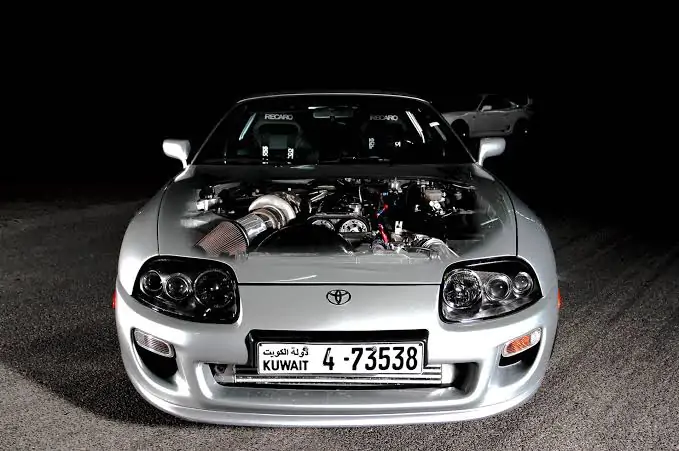What Engine Is In Supra Mk4 ? Unknown Story of Supra Mk4
Ferrari, Lamborghini, Porsche, and BMW were all quite busy marketing their sports cars in the 1980s. In Toyota’s facility, behind the quiet, shadowy doors, a monster was growing. Toyota assembled a team of its finest engineers and designers to work on Project A80, popularly referred to as Mk4 Supra. It was destined to dominate the JDM market later. Isao Tsuzuki, who has experience with both generation MR2 and first silica, was set to manage this initiative. The goal of Isao Tsuzuki’s design was to create the ideal sports car: reliable like a Toyota, fast like a 2000 GT, and comfortable like a Lexus.
A lot of the Supra Aerodynamic design was influenced by the 2000 GT, and the MK4 Supra has some of that DNA. From the long and low bonnet to the optional rear spoiler, it is obvious that the goal is to increase performance speed and dynamic economy. Additionally, the new design of the supra required a new engine. This would also be able to defeat the RB26, Nissan’s most popular engine at the time.
Supra MK4: Engine & Gearbox

So, the Toyota engineers worked hard to develop a new engine, but making an ordinary engine for the Supra was simply not an option. Engineers at Toyota trying to create engines that are reliable, have excellent performance, and can provide power when a driver puts them in a high-stress scenario.
In order to complete the engine design, Toyota scrap the V6 engine arrangement and concentrated on the inline cylinder configuration. So, the engine design is finalized. It is an inline six-cylinder engine in which the front three piston moves in opposite direction to rear three pistons, which cancels out its vibration and engine runs smoothly in high revs. To make the engine robust, it is constructed with a cast iron block. To increase the engine’s power, it is also equipped with a twin-turbo setup. However, Toyota aimed to compete with the RB26 engine, so they had to innovate. Instead of using a parallel configuration, Toyota engineers opted for a sequential twin-turbocharger setup. This configuration allows for quicker and better boost even at very low rpm. This innovation led to the creation of the legendary JDM engine, the 2JZ, whose full name is 2JZ-GTE. Thanks to the twin-turbo setup, the engine was capable of producing 276 horsepower. It was at this moment that Toyota engineers realized they had created a monstrous engine.
To handle this much power, Toyota used a powerful transmission of that time, capable of handling up to a thousand horsepower. With the 2JZ engine and V60 transmission, the Mk4 Supra was a bulletproof car. On one hand, Toyota engineers were busy creating a monster heart, and on the other hand, Isao Tsuzuki and his team were focused on crafting the monster body. Mr. Tsuzuki had a significant responsibility to ensure that the Mk4 Supra surpassed any of its predecessors in every aspect. He knew that for a car to have better handling and performance, it must be lightweight. Therefore, all the engineers worked hard to make the car as light as possible.
The Special Brakes
As fast as this car gains speed, it is also necessary to stop it. So, for the Toyota MK4 Supra, a special braking system was developed, directly inspired by Formula 1. In this system, a separate individual sensor is installed on top of each tire, which controls the braking system of the individual tire. Due to this revolutionary technology, the Supra can go from 112 km/h to 0 km/h in just 149 feet. This technology was so advanced and ahead of its time that it took almost a decade for other companies to break this braking record of the Supra.
The Launch

After all the testing was completed, Mr. Tsuzuki gave the green light to the MK4 Supra. In 1993, during the Toyota Chicago Motor Show, the Toyota MK4 Supra was unveiled to the whole world. The Toyota Mk4 was launched with two engine options: the 2JZ-GE, which produces 220 HP, and the 2JZ-GTE, which produces 276 HP. However, these specifications were only for the Japanese version. Toyota’s second-largest market was the United States, and Toyota knew that the United States loves bigger numbers. The Supras imported into the United States were re-engineered with stainless steel turbos, a revised crankshaft, and larger fuel injectors, allowing the Toyota Supra to produce 320 HP. Due to this increased horsepower, Toyota broke the Gentleman’s Agreement. Because of this engineering marvel with 320 HP, the Supra could easily beat every American muscle car. The Supra was able to achieve a speed of one hundred kilometers in 4.7 seconds.
Downfall Of Supra mK4
Toyota had very high expectations for this Supra, but Toyota had no idea about what the universe had planned for it. In the first year of launch, Toyota was able to sell only 2000 units. In the following year, Toyota had to face a new problem. While the NHTSA (National Highway Traffic Safety Administration) was testing the Supra, they identified 10 fault issues ranging from simple tire failure to brake failure. This led to rumors spreading throughout the market that the NHTSA had banned the Supra in the US. Consequently, the sales of the Supra declined as the years passed, and finally, in 1998, Toyota produced its last Supra, discontinuing its production. This was a heartbreaking moment for Toyota. If we talk about the previous generation of the MK3 Supra in the USA, one lakh units were sold. However, when we talk about the MK4 Supra, only 12,000 units were sold. Everyone thought that this was the end of the Toyota Supra.
Smokey Nagata And His Secret Supra

Then, once again, the universe flipped the coin. In 1999, a Japanese tuner imported his gold-painted modified Supra to the UK. At 4:00 AM on England’s A1 express highway, with his 900 HP producing top-secret Supra, he attempted a high-speed time attack and achieved a top speed of 370 km/h. This was the highest speed achieved on UK roads until that date. The driver of this car was the legendary Smokey Nagata. Because of this, Smokey Nagata had to face legal charges in the UK. This incident went viral all over the world. Many news outlets and magazines covered this stunt, but the funny thing was that the golden Supra did not have a 2JZ engine. Smokey modified his car by removing the 2JZ engine and swapping it with a Nissan RB26 engine to achieve that top speed. However, it did not matter to the people at that time. There were only two things on people’s minds: Smokey and the Supra.
Final Verdict
Almost 10 years ago, the time, money, and effort that the engineers and designers put into creating this masterpiece were being appreciated. The same car, 20 years ago, no one wanted to purchase, and today there is so much demand. The MK4 Toyota Supra is a living proof that nothing goes to waste. The MK4 has become a JDM classic and will always be a JDM classic.
Join Us : WhatsApp Channel
FAQ
The Mk4 Supra is propelled by the 2JZ engine, a straight-six powerhouse. This over-engineered marvel can produce over 1000 horsepower without internal modifications, making it an icon in automotive history.
In 1999, a modified Mk4 Supra hit 197 mph on UK public roads with over 900 horsepower. This feat catapulted the car to stardom, and it has been associated with supernormal speeds ever since.
The interior was crafted for maximized driving pleasure. The dashboard features two sections: one angled toward the driver for easy control access and another with a curved flat surface and a large glovebox compartment.
Like fine wine! Despite being over 20 years old, the curvy design, chunky rear spoiler (optional on the turbo-2JZ), and wider 17-inch wheels make it look right at home among modern classics.
Yes! Finding a stock Mk4 Supra is rare. Most have been modified, with average road versions now producing around 700 horsepower.
It’s a modifier’s dream! The Mk4 Supra remains an enduring symbol of Japanese engineering prowess and performance.
Toyota aimed to compete with European luxury brands and redefine luxury by combining performance, reliability, and innovative features.
It forced other luxury brands to improve their offerings by emphasizing reliability, customer service, and attention to detail.
Its blend of performance, style, and the legendary 2JZ engine continues to captivate enthusiasts worldwide.
Absolutely! Its status as a modern classic ensures it remains a beloved icon among car enthusiasts.
